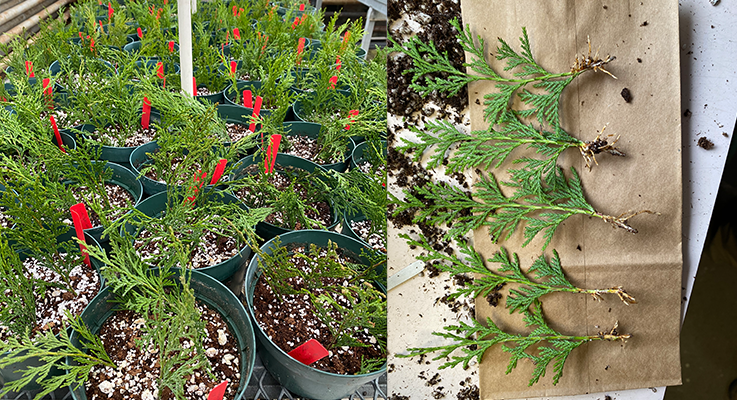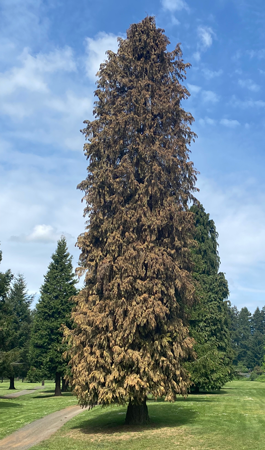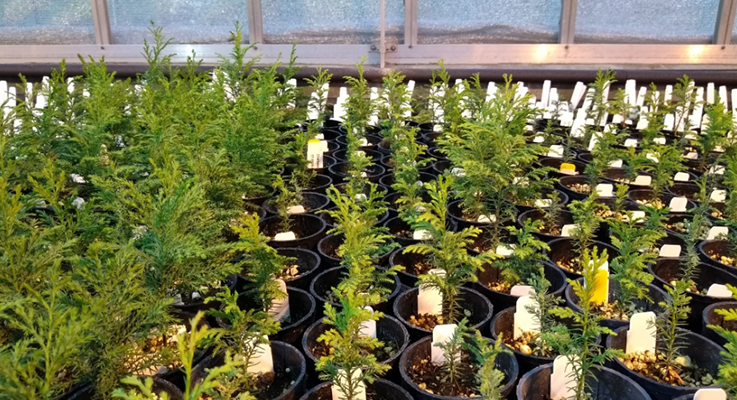Breeding disease-resistant Port Orford cedar for reforestation and the horticulture industry
By Ryan Contreras and Richard Sniezko

Port Orford cedar (Chamaecyparis lawsoniana) is a long-lived conifer native to northwestern California and southwestern Oregon. It spans an elevational range from sea level to 5,000 feet or more.
In forestry, the tree has both economic and ecological value (Zobel et al.1984). The species has also been very popular horticulturally in the U.S., as well as internationally, where it is often referred to as Lawson’s cypress.
The inadvertent introduction of a non-native pathogen, Phytophthora lateralis, was first documented in 1923 in a nursery in Seattle, Washington. It is the causative agent of the deadly Port Orford cedar root disease.
This pathogen was first found in the tree’s native range in 1952. It now has been documented in several countries in Europe where the tree has been planted. The resulting disease is deadly to both young seedlings and old growth trees. Its presence has had huge negative impacts on the tree’s use in horticultural plantings (Justice 2002), has harmed forest ecosystems, and has hampered the tree’s use in reforestation (Zobel et al. 1984, Betlejewski et al. 2011).
A new hope
Fortunately, when researchers tested Port Orford cedar trees for cedar root disease resistance, they discovered and documented that at least some of them do possess that trait.
The USDA Forest Service (USFS) and the federal Bureau of Land Management (BLM) initiated a large-scale resistance breeding effort in 1997, aided by pathology support at Oregon State University (Sniezko et al. 2012), which continues today. The program is based at the USFS’s Dorena Genetic Resource Center (DGRC) near Cottage Grove, Oregon.
Disease resistance testing has been done on thousands of parent trees and their progeny (family). Researchers found both major gene resistance (MGR) and quantitative disease resistance (Sniezko et al. 2020). In seedling testing, the progeny of the most susceptible parent trees have no survival and experience fast mortality. In contrast, depending on the type of resistance, survival of in resistant seedling families can vary from low to 100%.
Rooted cuttings of trees with MGR show little or no mortality in inoculation trials. To date, no virulence to resistance has been documented. Initial field trials are encouraging, but they will need to continue to be followed to track durability of resistance.

Containerized seed orchards have been established at Dorena, incorporating both types of resistance to produce open-pollinated seedlots for reforestation and restoration, with potentially 30–50% of progeny expected to be resistant. The goal of the orchards is to also provide high levels of genetic diversity for the 13 breeding zones that cover the range of environments in which the tree naturally occurs. Resistant seed is currently being used by several organizations and individuals.
Breeding to combine the resistance types and to increase the percentage of resistant seedlings from orchard seedlots is underway. For horticultural purposes, it should be possible to produce cultivars that have the highest level of resistance. Genetic diversity could be added to urban forest plantings by increasing the number of cultivars available.
Due to concerted efforts and support of the groups involved, the effort to develop populations of Port Orford cedar resistant to the root disease is moving quickly. It helps that the tree is biologically conducive to this, allowing researchers to test for resistance relatively quickly, generate rooted cuttings, produce seed from self-pollination, and induce pollen and seed cone production on very young trees.
Due to the root disease, the future of the tree initially looked bleak. In 2000, the International Union of Conservation of Nature (IUCN Red List), had listed the species as “vulnerable.” However, due to management practices including the resistance program, the IUCN downgraded its status to “near threatened” in 2013. The organization did so with the expectation that it will be listed as a species of “least concern” within 10 years if current conservation actions are successful and maintained, including the planting of resistant seedlings (Farjon 2013).
Horticultural use

While the USFS has a mission to ensure the long-term survival of this majestic native in the wild, gardeners around the world have come to love the myriad forms that have been selected and used in cultivation. To make the transition to horticultural use, collaboration between the USFS breeding program and Oregon State University was initiated to investigate two aspects of the project.
First, the USFS researchers noted that when seedlings were grown from self-pollinated progeny of the high resistant parent ‘117490’, that approximately 25% of them were dwarf and had distinctly blue foliage compared to others in the same family that were the standard green form (Figure 1). Seedlings were grown in Corvallis, and we observed that one quarter of the progeny exhibited the unique phenotype, suggesting the traits are linked and both recessive.
Research is ongoing to select “winners” from that group, including confirming that the selections exhibit resistance, propagate well from stem cuttings, and perform well in container production as well as landscape trials. The range of cultivars we currently are working toward have a relatively narrow phenotype — essentially a dwarf blue selection. However, future research will include controlled crosses to hybridize resistant clones with the vast array of cultivars available in the trade.
The second area we are working on is to identify superior clones for cutting propagation to be used as a clonal rootstock to provide a reliable source of resistance for growers. We began by growing out 133 seedlings that were derived from resistant parent ‘117490’. All seedlings were grown in containers using standard production practices.
Five cuttings of each individual were collected on December 16, 2019 and treated with 8,000 ppm IBA talc and stuck in a 1 peat: 1 perlite mixture and placed under intermittent mist with bottom heat.
Overall, rooting was high among the entire group, but we observed enough variation for selection (Figure 2). We used a threshold of 80% rooting with an average of 10 roots per cutting as our selection criteria for clones to move to the next phase of the trial. Thirty-five clones met this metric, of which 33 were field planted for long-term evaluation and an expanded cutting trial. Plants were tip-pruned during fall 2020 to start encouraging branching and then heigh was reduced by one-third during spring 2021 to begin establishing plants as hedges.
The idea to provide a clonal rootstock with resistance is not new but has been a regular request from a few specialty growers but there may be greater demand once word spreads. There are countless cultivars that have been developed during the past 100 years or so and re-creating the entire suite of phenotypes with resistance to Phytophthora lateralis is not reasonable. As such, we hope to make some contribution to breed for a collection of ornamental and landscape phenotypes with resistance to be grown on their own roots but provide a clonal rootstock that will allow producers and enthusiasts to maintain the incredible diversity of forms and types that have graced our gardens and landscapes over the decades.

Next steps
The years of breeding have delivered what appears to be reliable resistance in Port Orford cedar that could be a boon to the nursery industry. The next stage of our collaborative research is evaluating resistance of advanced selections to ensure that we are maintaining expected levels.
Following disease testing, decisions will be made on clones to advance to grower trials — both as own-rooted cultivars as well as to be evaluated as clonal rootstocks.
Finally, we hope to begin making crosses to introgress disease resistance into a variety of ornamental forms to expand the palette of disease resistant cultivars that can be propagated and grown from cuttings. We hope that future generations will get to enjoy this species — both as a majestic conifer in its native range, and as a much-beloved landscape plant around the world.
Literature Cited
Betlejewski F, Goheen DJ, Angwin PA, Sniezko RA. 2011. Port-Orford-cedar root disease. Forest Pest Leaflet 131. U.S. Department of Agriculture, Forest Service, Washington, D.C. https://www.fs.usda.gov/Internet/FSE_DOCUMENTS/stelprdb5346825.pdf
Farjon, A. 2013. Chamaecyparis lawsoniana. In: IUCN 2013. IUCN Red List of Threatened Species. Version 2013.1. www.iucnredlist.org
Justice, D. 2002. The untimely demise of the Lawson Cypress. Pacific Horticulture. Pacific Horticulture | The Untimely Demise of the Lawson Cypress
Sniezko, R.A., Johnson, J.S., Reeser, P., Kegley, A., Hansen, E.M., Sutton, W., Savin, D.P. 2020b. Genetic resistance to Phytophthora lateralis in Port‐Orford‐cedar (Chamaecyparis lawsoniana) – Basic building blocks for a resistance program. Plants, People, Planet. 2: 69– 83. https://doi.org/10.1002/ppp3.10081
Sniezko, R.A.; J. Hamlin; E.M. Hansen. 2012. Operational program to develop Phytophthora lateralis-resistant populations of Port-Orford-cedar (Chamaecyparis lawsoniana). pp. 65-79. In: Proceedings of the fourth international workshop on the genetics of host-parasite interactions in forestry: Disease and insect resistance in forest trees. Edited by Sniezko RA, Yanchuk AD, Kliejunas JT, Palmieri KM, Alexander JM, Frankel SJ, and tech. coords (2012). Gen Tech Rep PSW-GTR-240. Albany, CA. Pacific Southwest Research Station, Forest Service, U.S. Department of Agriculture. 372pp. (http://www.fs.fed.us/psw/publications/documents/psw_gtr240/psw_gtr240_065.pdf)
Zobel, D.B.; Roth, L.F.; Hawk, G.M. 1985. Ecology, pathology, and management of Port-Orford-cedar (Chamaecyparis lawsoniana). Gen. Tech. Rep. PNW-184. Portland, OR; U.S. Department of Agriculture, Forest Service, Pacific Northwest Forest and Range Experiment Station. 161 p. http://www.fs.fed.us/pnw/pubs/pnw_gtr184.pdf. (31 December 2011).
Ryan Contreras is a Professor and Associate Head, Department of Horticulture, Oregon State University
Richard Sniezko is a Geneticist and Tree Breeder, Dorena Genetic Resource Center, US Forest Service



